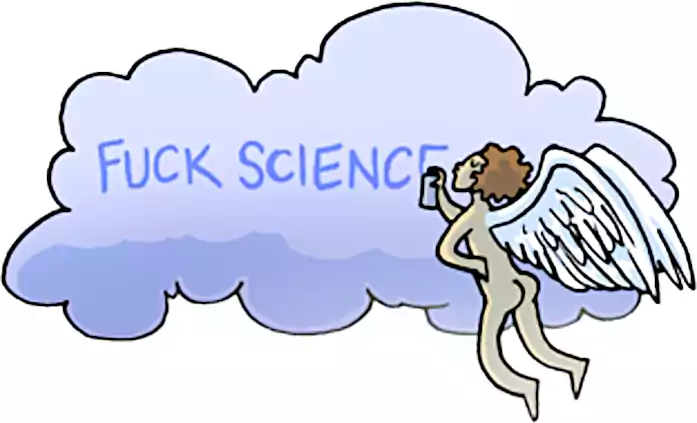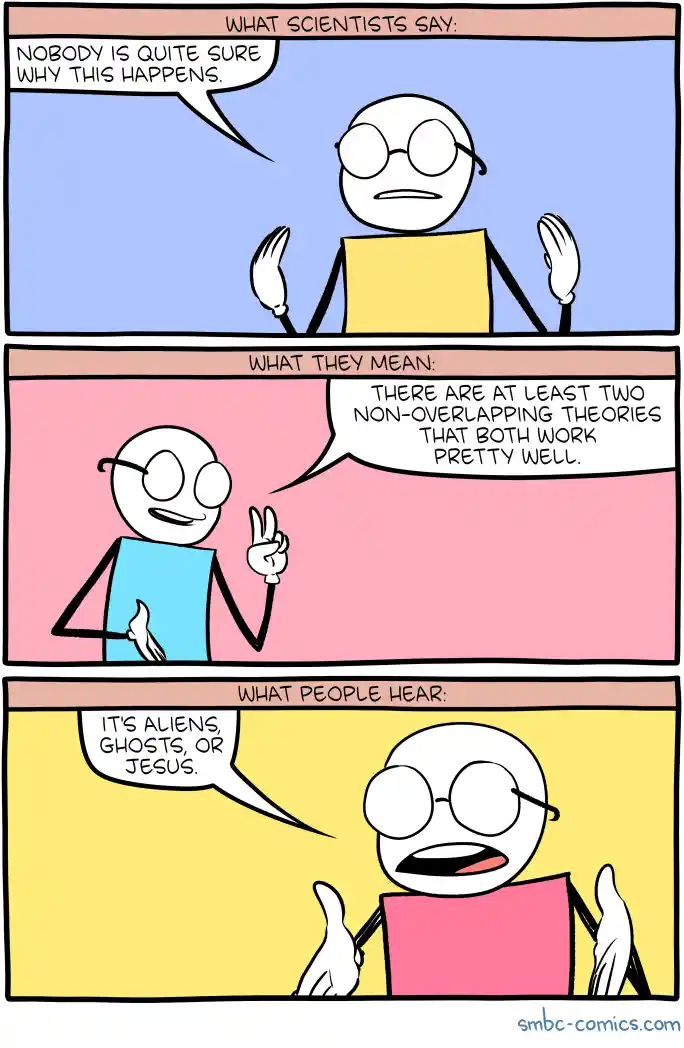Science communication
On making people feel they are smart enough to teach themselves, or failing that, that they are smart enough to fund YOU to teach yourself
June 1, 2021 — November 19, 2023
Suspiciously similar content
1 Philosophy of
For people who wish to learn actionable skills, we have teaching. But for people who have not yet decided to learn a thing, we have science communication, which I am not an expert in.
From what I have gathered, the most generous interpretation of the purpose of science communication regards the public as people who are ready and curious to learn about the world with just a little bit of pre-digestion of specialised information out of respect for their busy schedules.
A less generous version regards the public as the funders of science who should be pacified with a little infotainment so they will keep funding the real scientists to do real work.
Perhaps less generous still, science communication might be the supplier of trite factoids to make the audience sound clever when they regurgitate it somewhere else.
Most cynically of all, good science communication practice is a tool that can be weaponized in information warfare, for example in pseudo-scientific conspiracy theorising.
I prefer to focus on the first use case because I do not have the stomach for the others. I am not raising funding for a startup heading to an IPO, which is the thing that would pay me enough to swallow my pride for the next two use cases. I am currently implicated somewhat in (what I hope is) the first use case, so here are some useful links for my own reference.
Simis et al. (2016) says:
Miller’s formative work led to greater awareness of the need for public engagement with and communication of science and mobilized the scientific community to fill the deficit in knowledge among public audiences. Unfortunately, this approach assumes that scientific knowledge communicated to publics stands alone to encourage understanding and support of science. The interpretation of these facts is assumed to be identical for all members of the public. An assumption of rational reasoning underlies this strategy of public communication. If individuals interpret information in a rational and objective manner, many experts believe that the conclusions of public audiences will be supportive of science. This notion of the knowledge deficit model is epitomized in the phrase “To know science is to love it” (Turney, 1998).
Yet, empirical research has shown that public communication of science is more complex than what the knowledge deficit model suggests.
Cue memetics reference.
2 Interesting examples of
3 Communication with other scientists
4 Science communication for policy
See also science for policy.
5 Role of in the community of science
See scientific community.
6 Models of
I quite like this pyramid of science diffusion model which breaks apart the science/public nexus with a little more nuance.
I think a lot of things are getting obscured by the term “scientific establishment” or “scientific consensus”. Imagine a pyramid with the following levels from top to bottom:
FIRST, specialist researchers in a field. So for example the people doing studies on the effect of dietary cholesterol, or the people dissecting monkey brains to see how much serotonin is in them. These people always have the latest cutting-edge experimental results and a good knowledge of the issues involved in the field.
SECOND, non-specialist researchers in a broader field. Nutrition scientists in general. The guy who is interested in Vitamin B, but goes to the same conferences as the guys studying cholesterol. The research psychiatrist working on schizophrenia, but who maintains a keen interest in what her colleagues over in the depression lab are doing. They know enough about the broad principles of the field to be able to understand and evaluate new ideas more quickly than everybody else, but they still only learn about them the same way everyone else does — by waiting for the specialist researchers to tell them.
THIRD, the organs and administrators of a field who help set guidelines. The head of the USDA who’s in charge of looking over the Food Pyramid to make sure it’s accurate. The APA Committee for deciding exactly what wording to use in the guidelines on depression treatment. The head of Harvard Medical School who has to decide what to put in the curriculum. The editor of the New England Journal of Medicine, who has to decide what gets published.
FOURTH, science journalism, meaning everyone from the science reporters at the New York Times to the guys writing books with titles like The Antidepressant Wars to random bloggers.
ALSO FOURTH IN A DIFFERENT COLUMN OF THE PYRAMID BECAUSE THIS IS A HYBRID GREEK PYRAMID THAT HAS COLUMNS, “fieldworkers”, aka the professionals we charge with putting the research into practice. In nutrition this is doctors and dieticians, who directly inform their patients what to eat. In education research this could be teachers and principals who directly decide how classes will get taught. In sociology it might be the police chief trying to institute a new crime-fighting program. Et cetera.
FIFTH, the general public.
Two other models of interest:
- the hype cycle, and
- the simulacra.
7 Incoming
- Academia should incentivize mathematicians to make their work more accessible
- What makes science contentious?
- Forewarned is forearmed
- SKYPE A SCIENTIST
- The Dissemination Game: Incentives of In-Person vs Virtual Participation
- Erik Hoel, Why do most popular science books suck?


